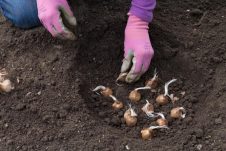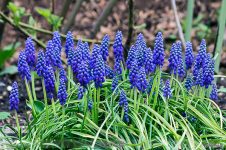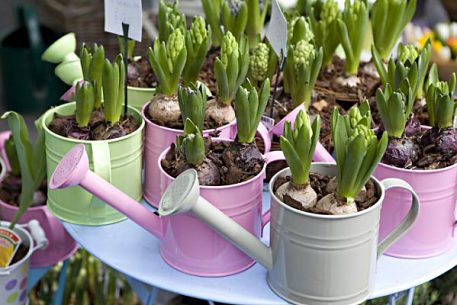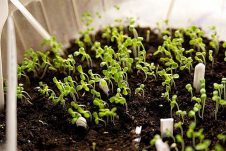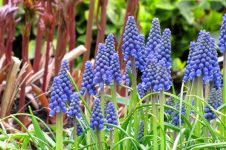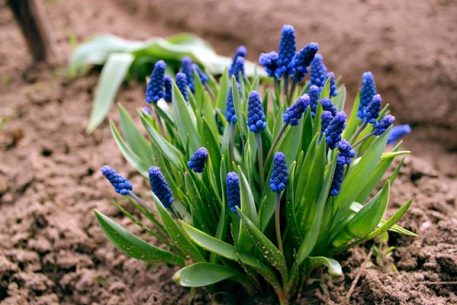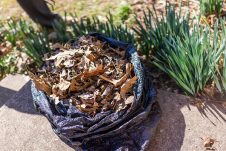These unpretentious onion plants with a nutmeg aroma are often grown for holiday bouquets. They somewhat resemble a beautiful hyacinth, only of a smaller size, for which they received their second name - mouse hyacinth. Graceful muscari are placed in rock gardens and discounts, grown as border plants.
Material Content:
Description of species and varieties
More than fifty forms of muscari are known, almost all of them are decorative. Another name for this perennial from the Asparagus family is the viper bow. The natural habitat of growth is the Eurasian continent and North Africa, the flower was introduced into Australia and America.

Most varieties come from the Mediterranean, Turkey and other warm countries. In gardens, frost-resistant Armenian muscari is often found. It has a small bulb up to three centimeters in diameter and long lanceolate leaves. Peduncle height about 20 cm. Inflorescence brush with bright blue barrel-shaped flowers.
Known varieties:
- «Cambridge» (Cantab) - a variety with blue flowers, late flowering, stunted;
- «Christmas pearl» (Christmas pearl) - blue-violet flowers;
- «Fantasy creation» (Fantasy creation) - blue-green terry muscari;
- «Sapphire» (Sapphire) - long-blooming dark blue form;
- «Blue spike» (Blue spike) - inflorescences consist of one and a half hundred blue fragrant flowers, blooms in late May.
In decorative gardening, the following types of muscari are grown:
- Tubergen - blue flowers with teeth of a lighter color, bloom in April, the soil for growing needs well-drained soil, the plant does not tolerate water stagnation;
- tree-shaped - barrel-shaped flowers of a purple hue with white teeth, there are white-flowered garden forms, flowering begins in the first decade of May, the height of the plant is about 12 cm;
- changeable - the teeth of the flower corolla are bent inward, the flowers are blue-violet, ovate-oblong;
- crested - an inflorescence with a funny crest at the top is not dense, like other species, but friable, flowers are brown with a beige edge, there are cultivars with purple flowers;
- long flowered - sky-blue flowers with a white border bloom in the last decade of April;
- broadleaf - a thermophilic variety, an inflorescence with dark purple flowers of a lighter color at the top;
- white-green - Corollas of flowers purple, barrel-shaped, with a white edging;
- large fruited - loves heat, does not tolerate negative air temperature, can be grown on a flower bed only in the southern regions;
- pale - a small flower, about 15 cm high, with bell-shaped flowers, along the edge of which there is a white edging, the color is blue, pink, white;
- strange - flowers are dark lilac, the inflorescence is conical, height is up to 15 cm.
Florists are also known species of muscari: Sovicha, multiflorous, Sosnowski, fine flowered, pretty, Azerbaijani.
Muscari landing in the open ground
It is advisable to plant the plant on a flower bed in the first decade of September or the last of August.
Planting mouse hyacinth in open ground:
- On the day of planting, the bulbs are treated with a fungicide solution, and only then they are planted.
- Planting depth should be 3 onion heights. The packaging may indicate a depth of 10 cm, but this is too much for muscari.
- Wells are prepared in advance, well watering the soil, coarse river sand can be poured into the bottom, it will serve as a good drainage.
- Between plants make a distance of 5 to 10 cm.
- After planting the bulbs, they are watered and mulch the soil with compost.
Sometimes during spring holidays you can see on sale blooming muscari, they are also suitable for planting on a flower bed.
Such plants will bloom next year on time.
How to care for flowers
During flowering, primroses require abundant watering. Otherwise, these flowers are very unpretentious. When flowering ends and a dormant period sets in, excess moisture is not needed for the bulbs, the ground should remain dry.
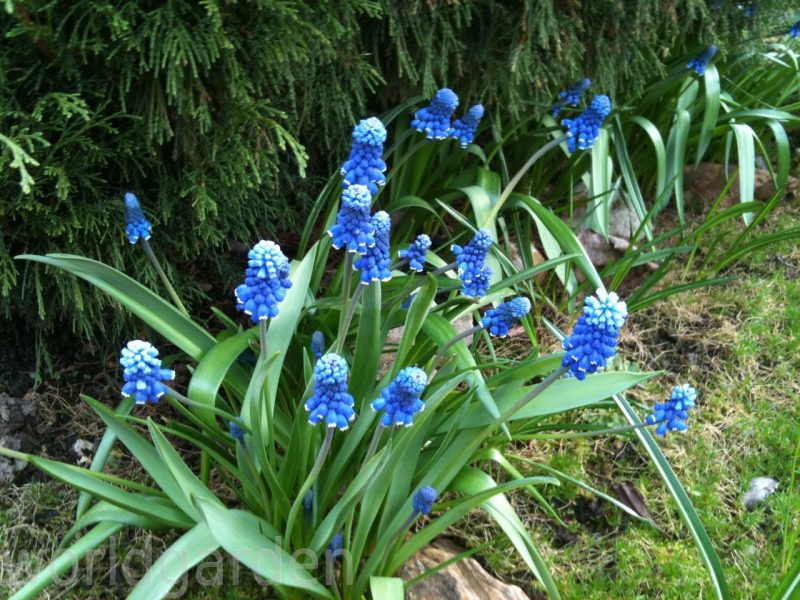
If the soil on the site is infertile, it is advisable to feed the flowers. In autumn, a high-quality compost or humus is made on the flowerbed (about 1/2 bucket per 1 m2).
Flowering of different varieties and species may not coincide in timing, but usually it occurs in the spring within 20 days. Care at this time consists in watering, loosening the soil, removing wilted inflorescences and weeding.
Muscari are great for distillation.
When there is still snow outside the window, you can get a bouquet of beautiful blue flowers at home. You can grow them on the windows with bright diffused lighting. Such bulbs will bloom in the pot only once, therefore, after flowering, it is advisable to plant them on a flower bed.
Large, healthy bulbs that are suitable for distillation are selected in August for transplantation. They can be planted in September using a mixture of black soil and sand. The bulbs in the container during planting are placed tightly to each other. Until sprouts appear, the air temperature should be no more than +8 ° C. Do not forget about watering. After about 2.5 months, the bulbs with sprouts are transferred to a warmer room, where the air temperature is +12 ° C. Soon after, flowering begins within a month.
Reproduction of mouse hyacinth
Muscari is propagated by daughter bulbs. They are separated from the mother bulb during plant transplantation. Transplant bushes at the age of 5 years or earlier. You can judge the need for planting a bush by its appearance. There are about 3 dozen daughter bulbs on 1 plant.
In addition to the vegetative method, flowers reproduce well by seeds.
To prevent the uncontrolled spread of culture by self-sowing, after flowering, part of the peduncles are removed. Ripened seeds are harvested and stored for sowing no more than 1 year.
Sow seeds in the open ground in autumn to a depth of not more than 1 cm. Crops are not watered. Thin stems of seedlings can be seen in the spring, they will tell you that new bulbs have begun to form. The specimens grown from seeds will bloom only 3 years after sowing.
Protection against diseases and pests
Muscari are resistant to disease and pests. Excessive watering should be avoided while the bulbs are at rest.
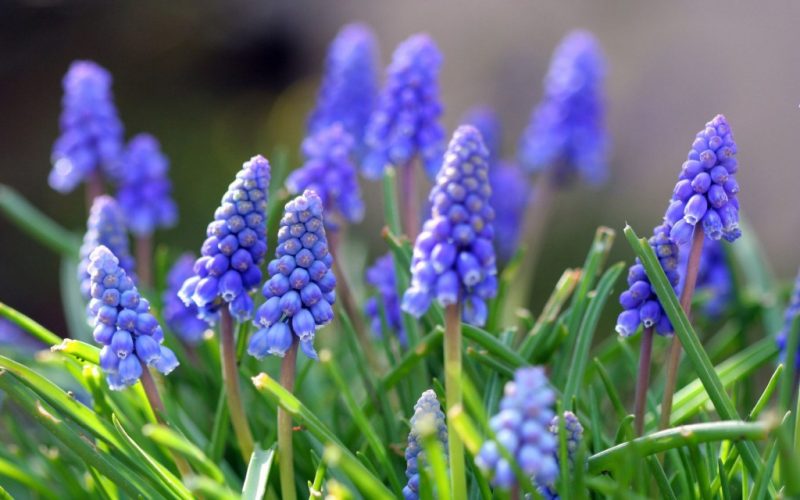
Sometimes the plant is affected by a disease that causes the yellow dwarf onion virus. The leaves are covered with green mosaic spots and dots, growth is slowed down, the flower arrow grows shortened. Sick plants are dug up and destroyed.
Muscari are treated in exactly the same way, in which leaves are deformed, becoming covered with pale strokes and spots, such changes are caused by the cucumber mosaic virus.
The aphid is the carrier of viral infections. To prevent diseases, they destroy insects by noticing them on plants.
You can fight aphids by applying simple folk remedies - dilute 3 tsp. liquid soap in 3 tbsp. water, and spray on the leaves. Also 2 tbsp. l dilute ammonia in 10 liters of water, sprinkling on a sheet. Repeat after seven days. If Muscari has chosen a spider mite, they are treated with actophyte and phytoerm.
How mouse hyacinth hibernates
Unpretentious flowers mouse hyacinth winter well in open ground. Many gardeners believe that they generally do not require special care. However, growing experience shows the opposite.
After flowering, the Muscari has a dormant period. Withered flower stalks must be removed and the plants fed with fertilizer containing potassium and phosphorus.
This will help the bulbs to better prepare for the winter.
Watering is gradually reduced, and when the leaves turn yellow, they are cut off and the plants are no longer watered. In the autumn, they dig a plot, seating Muscari who have reached 5 years of age.
So that young bulbs do not suffer during severe frosts, you can mulch the flower bed with compost, sawdust, tree bark, oak leaves. The mulch is laid out on the surface with a layer of 10-15 cm, before this the soil is watered and loosened.
Digging and storing Muscari bulbs
Digging up the bulbs is not necessary, but possible, as the muscari are not afraid of frost. If there is such a need, you need to know a few rules in order to preserve the bulbs until spring.
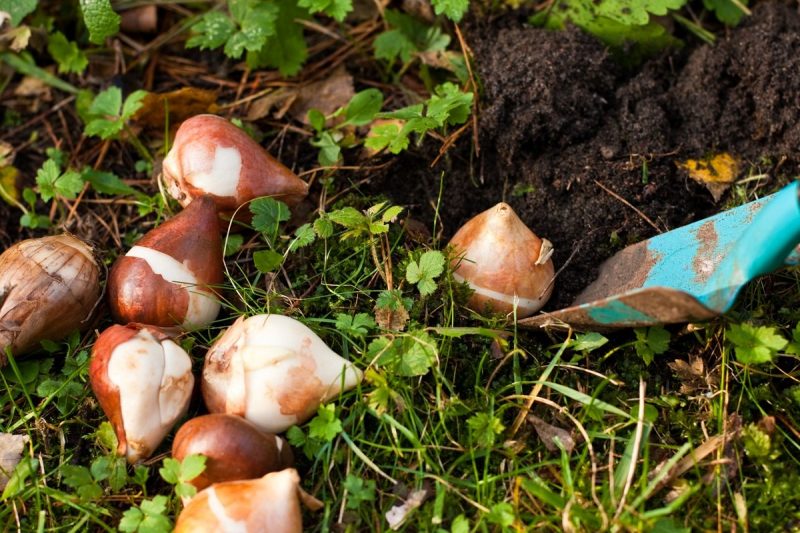
Operating procedure:
- dig a plant after wilting leaves;
- dry for several days;
- placed in sand or peat;
- stored in a dark room at a humidity of 70% and a temperature of 17 ° C.
Primroses are planted in open ground at the end of summer or autumn, when they dig a plot. Therefore, it makes no sense to store dug bulbs indoors until next spring.



